Developers are the backbone of the tech industry, and building relationships with them is critical for tech companies to succeed. Developer marketing, developer advocacy, and developer relations are all fields that aim at engaging with and supporting developers, but each has a distinct focus and a distinct set of responsibilities.
Before we get to the differences between the three, let's first learn what these terms actually mean and how exactly they work.
What is Developer Marketing?
Developer marketing is the method of promoting a tech company's products and services to developers via content, events, and meetups with the ultimate aim being the adoption of the company's technologies.
How is developer marketing different from conventional methods of marketing?
In traditional B2C marketing, companies use colourful ads involving attractive graphics and huge fonts, big CTAs that push the potential customer to commit. This approach has worked well in the e-commerce sphere but in developer marketing, it has the opposite effect. Developers hate advertisements with a passion, they use ad blockers and a multitude of other methods to avoid ads. So what, then, is the best approach to market products to developers?
How can you promote your products among developers?
It's simple: by not "promoting" them at all. Okay, that's a bit of an exaggeration but hear us out.
Developers only tend to trust other developers and they are extremely allergic to marketing. In short, developers view rote advertisements as trash, and generally think very poorly of marketing.
Instead of outright promotion of a product, a better approach, usually, is quality content that's educational at its core. Developers are hard to impress and even harder to persuade.
But going with an educational approach involving a how-to tutorial that shows how you built something interesting while incorporating your product or service - now that is much more likely to pique the curiosity of a developer and get them to check out your content.
Here you could talk about how exactly your product helped you - including where it didn't help as much.
Talking about both advantages and disadvantages gives a fair overall picture of a product and helps maintain objectivity, which is something that is highly appreciated by developers. This goes a long way in building trust among developers.
It's important to understand that developer marketing is not an overnight process. It's a slow and often tedious task and involves multiple steps and depends on the medium you're using for your developer marketing efforts.
Let's take a look at developer marketing through written content, for instance.
The first step is understanding the product that you're trying to market. Then, like traditional copywriting, you can use tools like Google Trends or Adwords to research some keywords that you can plug into your content for SEO benefits. However, it's more beneficial if you can integrate the technology you're looking to promote with an already-established name in the market.
For instance, consider the following title:

This article is a how-to guide about creating a survey using React and SurveyJS.
Or you could create a listicle where you talk about the product you're promoting alongside other established products.
For example, consider this listicle we wrote about top documentation tools, titled thus:

Another strategy that you can leverage is the use of a topic that's trending in the tech world at present.
For example, take a look at this how-to guide we created for one of our clients, written by one of our in-house developers. It deals with integrating ChatGPT - a hot topic at present - into a project.

Presently, this piece sits at 3.7k overall views with the majority of traffic coming from Google.
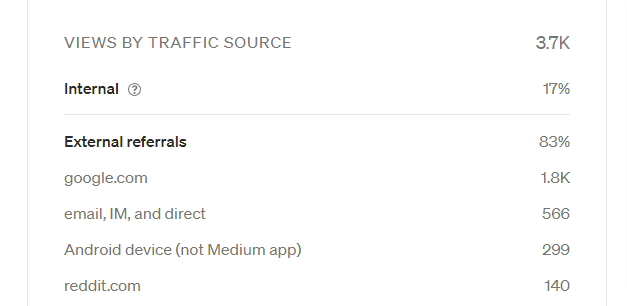
If you search with the query "Use ChatGPT as an Educational Chatbot", you'll find that this article ranks 2nd - just below OpenAI's own blog post.
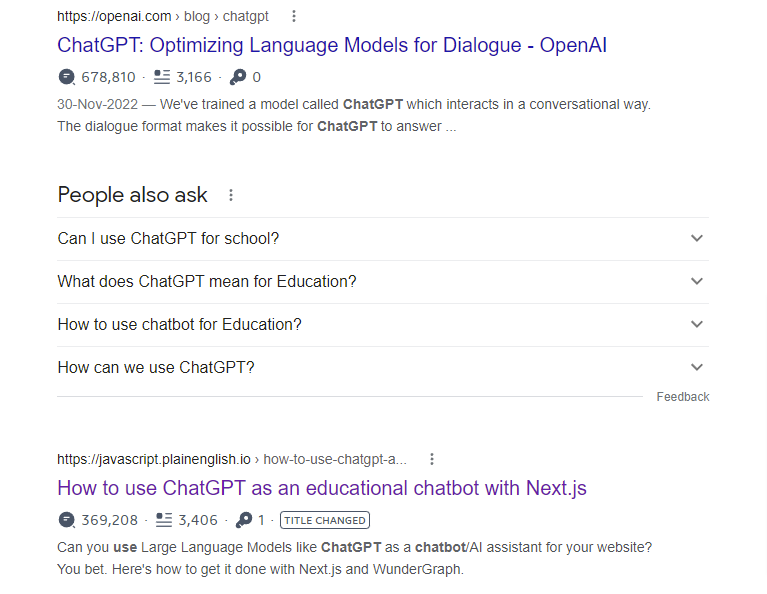
Bear in mind that ranking 2nd on Google isn't a walk in the park, and an article can hold onto its rank or rank better only if the content provides value to the reader who searches for it.
But also consider the fact that just dropping a popular name in the title isn't going to fetch more views. Sure, it might be a success in the short term but in the long run, it won't work out.
Our In Plain English publications (JavaScript, Python, AWS, and AI) which cumulatively receive over 3 million visitors, enable us to gauge the success of each type of content. The articles on our platform cover the full spectrum - ranging from listicles to comparison pieces, and technical guides to opinion pieces.
Sometimes a controversial opinion piece, titled, "Angular is Costing Companies Billions" might bring a lot of short-term traffic, but our stats show that it's the how-to tutorials that withstand the test of time - consistently bringing traffic to our platform.
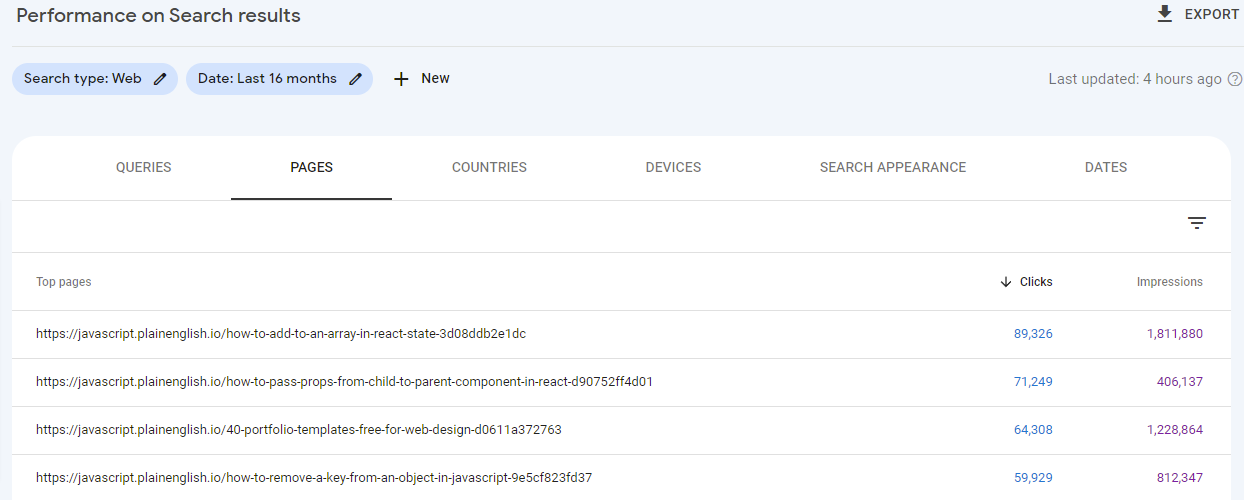
As you can see above, 3 out of the top 4 articles, sorted as per the highest number of clicks, are how-to guides and one of them is a listicle.
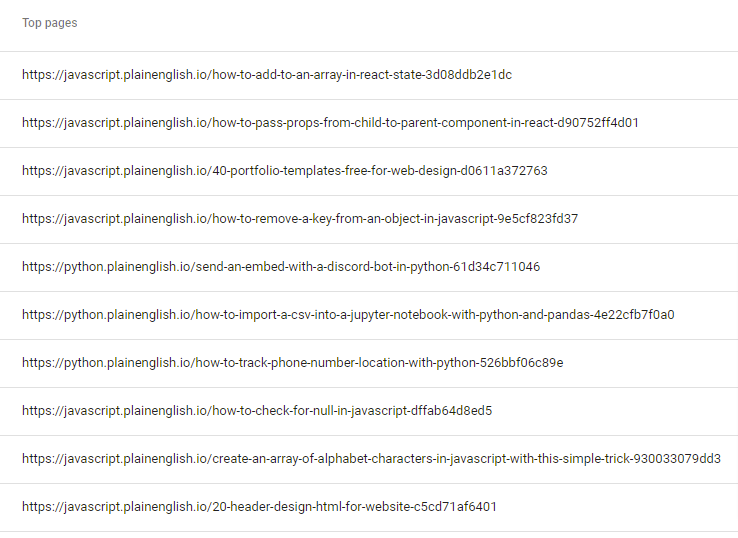
In the list of top 10, none of them is a controversial piece. From this list, it's quite clear what kind of content actually clicks with developers - the demographic that forms two-thirds of our audience.
Articles and blogs are not the only means of marketing your product to developers. Social media, newsletters, social forums like HackerNews and Reddit, Youtube videos, Dark socials like Facebook groups and Discord channels, conferences and meetups and paid ads on Google, Youtube, Twitter, etc. (could sometimes be in the form of memes) are also other ways to market products to developers.
How can You Measure the Success of Your Content?
You can track the traffic to your content using Google Analytics and to take it a step further you can also use referral links for all the links you insert in your content to track the number of clicks you receive.
However, developer marketing is not simply about which content brings more traffic. It's a lot more complex and requires a much deeper understanding and a lot of effort in terms of content strategising, creation as well as distribution (here's a short guide we put together in this regard).
Despite all efforts, sometimes, it might take weeks for your content to take off and even then it might not translate to sign-ups. After all, developers are not easy to win over, hence it's important to remain patient and keep crafting content with the intent of providing value to developers instead of blatant promotion.
To sum up, creating content - whether it's written, or audio/visual - that's rich in value and not just a sales pitch is what sets developer marketing apart from other forms of marketing. This spreads awareness, builds trust, and ultimately leads to sales and adoption. However, it's a long-winded - and often frustrating - process but crucial for the success of a tech product.
Now then...
What is Developer Advocacy?
Developer advocacy is all about building relationships with the developer community. At the heart of this is the need to establish trust between the company and its users. This trust can be built in a variety of ways, but the key is to provide value to the developer community.
How Developer Advocacy Works
Developer advocates are often experts in the company's products or technologies, and they can provide invaluable support to developers who are trying to use these technologies. By helping developers overcome technical challenges and providing guidance on best practices, developer advocates can build trust and establish a positive relationship with the developer community.
The 3 Pillars of Developer Advocacy
Successful developer advocacy is a combination of quality content creation, community building, and an effective feedback loop involving external developers and the in-house product development team. We'll take a look at each of these in the following lines.
1. Content Creation
Creating technical content is an important part of developer advocacy. Its goal is to provide valuable and relevant content that helps developers, who have newly adopted the company's product, learn and familiarise themselves with the technologies. Using engaging and educational content, developer advocates can help existing users get the most out of the company's products or tools.
This type of content can take many forms, including blog posts, such as MongoDB's Engineering Blog for instance:
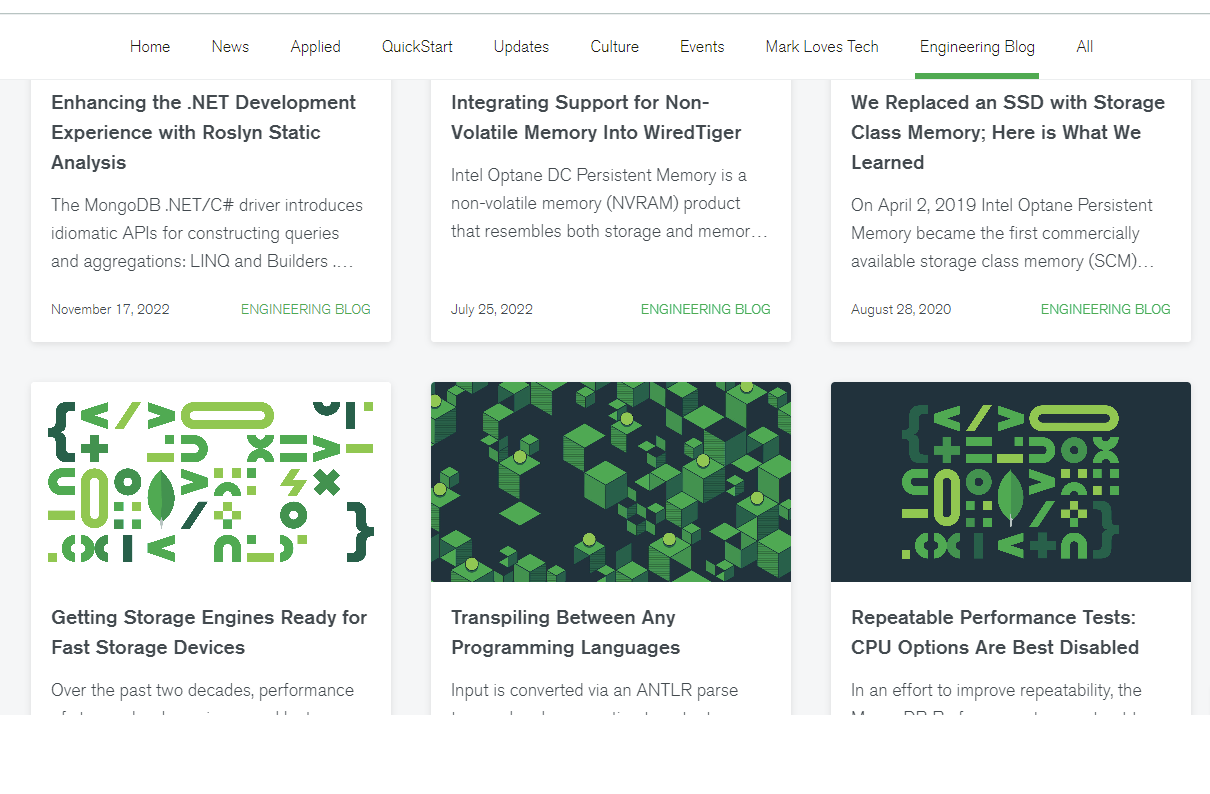
Videos (from React's Community Resources, for example):
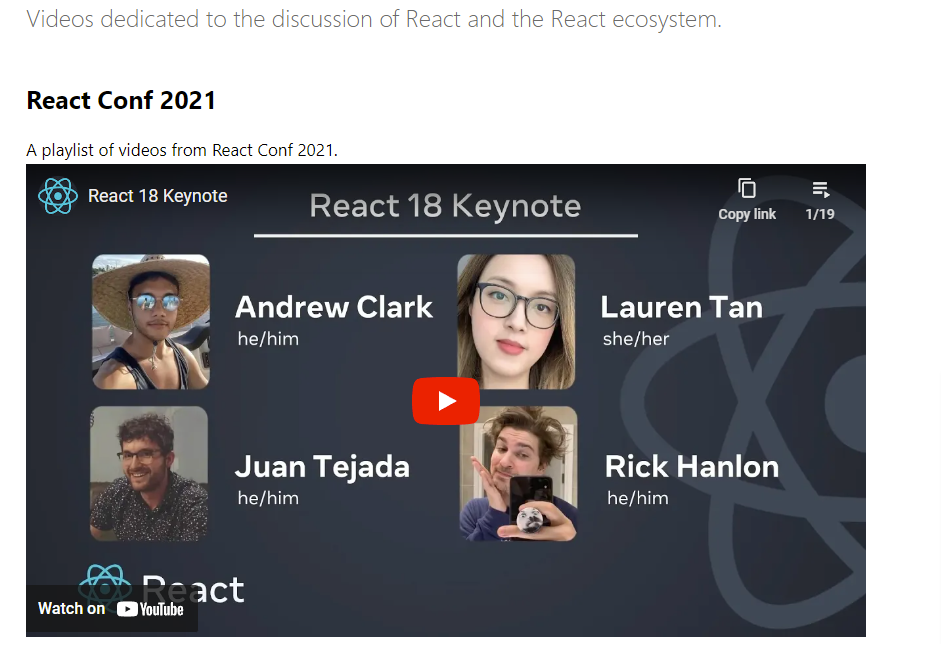
Tutorials (from Vercel's guides, for instance):
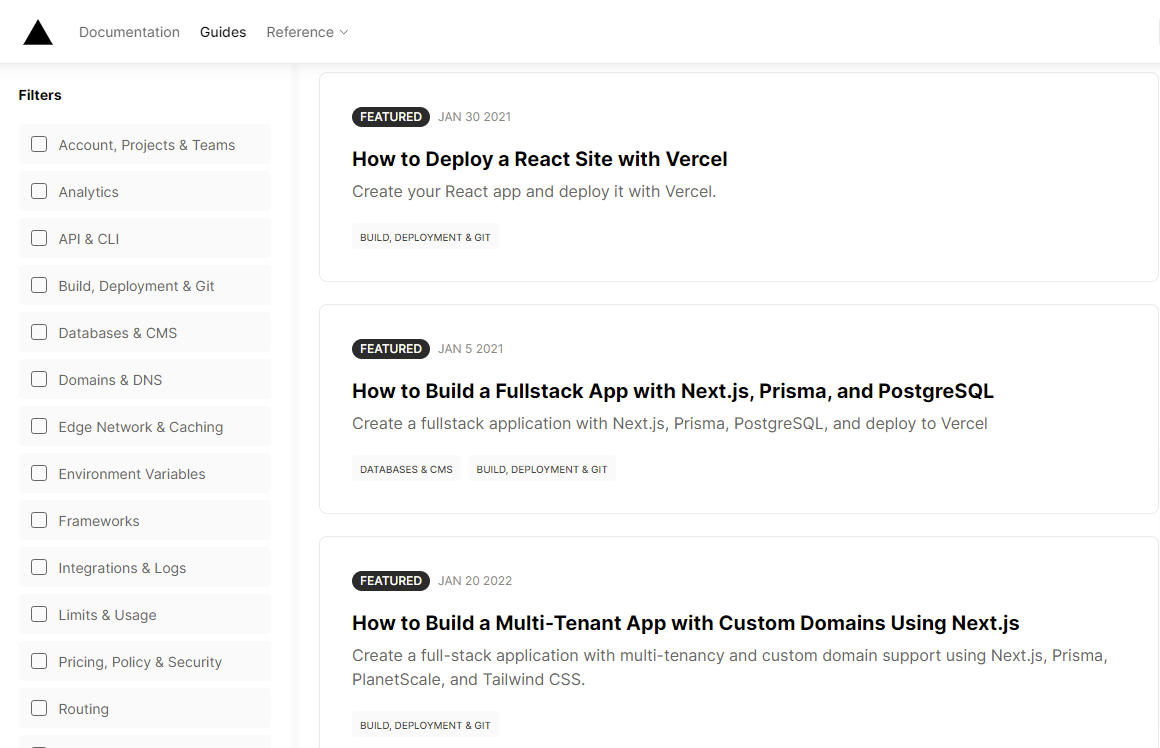
And sample code (like in the case of GraphQL).
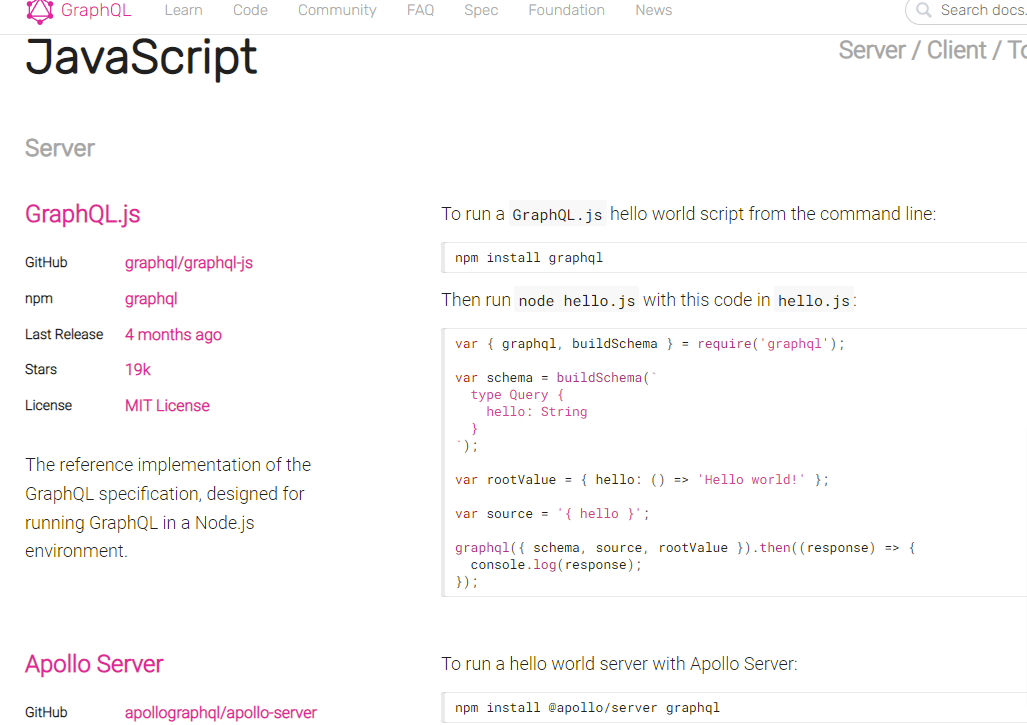
These not only help existing users but can also help in spreading brand awareness among new developers. Existing developers who have benefitted from the company's products and guides might in turn spread the word among other developers through word of mouth or via blogs/vlogs. This makes content an irreplaceable component of developer advocacy.
2. Building and Nurturing a Developer Community
Another aspect of developer advocacy is community building and maintenance (let's consider the official dev communities of GraphQL for instance).
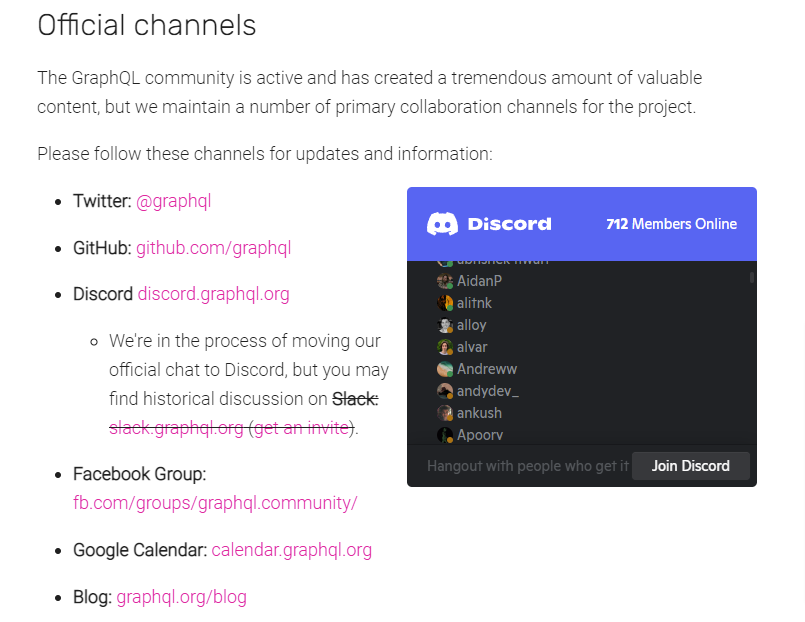
Developer communities are an integral part of developer advocacy. In such communities, developer advocates often organise and participate in events, meetups, and other activities (take Python's DjangoCon for instance), that bring developers together. This helps to create a sense of belonging and shared purpose around the company's products or technologies, and it allows developers to learn from one another and collaborate on new ideas.
Both community and content go hand in hand. One can't work without the other. A good developer advocate realises this and labours not only to build a community but also keeps it active and engaged with proper content.
3. Communication/Feedback
Developer advocacy isn't a one-way street. Developer advocates don't simply create content or offer help to the community, they are meant to receive feedback from the community and relay it back to the product development team, who then implement the feedback and launch updates for the product. This feedback loop is a continuous process and pretty much takes place throughout the lifecycle of the product.
Developer advocates act as the conduit between the company and its users, collecting feedback and insights that can be used to inform product development and roadmap decisions. Gathering feedback from the developer community is crucial for companies that want to create products that meet the needs of their users.
Sometimes, a given product might not even look like the originally conceived idea - but might resonate better with users.
Role of Developer Advocates
Good developer advocates are ideally developers themselves with the ability to empathise with both internal and external developers. They relay the feedback from the user to the product development team. The ability to empathise with the user's sentiment will ultimately translate to accurate feedback that would help shape a better product.
Similarly, being a developer would enable a developer advocate to properly understand the pain points of the internal product team and also get a better understanding of the product itself. This would later enable the developer advocate to create better and more engaging content for external users/developers.
So, when exactly do developer advocates come into play? You might think developer advocacy comes into consideration after a product has been launched. Because without a product you can't really create content about it nor can you gather feedback, right?
Actually, no.
You'd be surprised to know that often the first users to test a company's product are the company's developer advocate team and if it's not up to scratch then their feedback helps in improving it. Eventually, after several rounds of feedback, the product becomes ready for launch and the developer advocate is then again called upon to spread the word to the external community.
The image below depicts the role of a developer advocate team in a typical tech company.
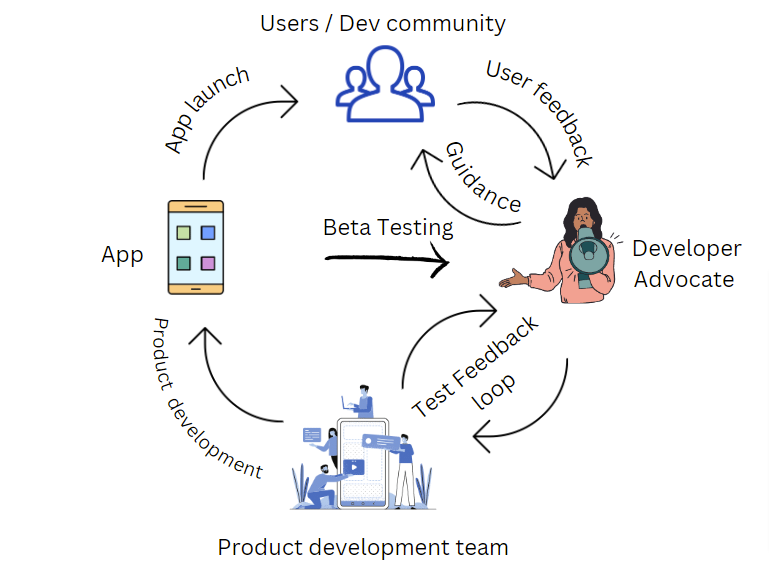
How to Measure the Success of Developer Advocacy?
The success of developer advocacy can be measured through in two major ways:
- The number of developers who engage with the company's products or services. This can include the number of downloads of an SDK or API, the number of questions asked in a developer forum, or the number of attendees at a developer conference.
- The level of engagement that developers have with the company's content, such as blog posts, videos, and social media posts. This can be measured by the number of views, likes, shares, and comments.
To sum up, Developer advocacy is about building relationships and establishing trust with the developer community. By providing technical guidance, creating valuable content, building a community of developers, gathering feedback, and even providing feedback, companies can create products that meet the needs of their users and build long-lasting relationships with their developer community.
What is Developer Relations or DevRel?
As per Wikipedia, developer relations or DevRel is a broad term that encompasses both developer marketing and developer advocacy and is focused on building and maintaining relationships with developers.
Dev Rel teams typically include developer advocates, technical evangelists, community managers, and other specialists. Their objective is to build and maintain relationships with developers, attract and nurture new talent, and promote the use of a company's products and services among developers while advocating for their interests within the company.
Let's take a look at how it works.
How Developer Relations or DevRel Works
Developer relations professionals typically have a deep understanding of the needs and challenges of developers and work closely with the development team to ensure that the company's products and services are meeting those needs.
A good developer relations program is typically framed around the following four aspects:
- Advocacy
- Community Management
- Education
- Marketing
Advocacy
The role of a developer relations professional is to act as a liaison between developers and the company - advocating for the needs and interests of developers while also representing the company's perspective and goals.
This requires not only technical expertise but also excellent communication and collaboration skills. Developer relations professionals must be able to explain complex technical concepts and best practices in a way that's easy for developers to understand.
Community Management
This involves building and nurturing a strong community of developers by organising events, providing technical support, and facilitating discussions and collaboration. And developer relations professionals typically engage with the developer community through a variety of channels, including social media, forums, and events (both virtual and in-person).
They also gather feedback and insights from the developer community to help improve the company's products or technologies and to inform product development and strategy.
Education
Some common activities in developer relations include creating technical content such as blog posts, tutorials, and documentation to help developers learn how to use and develop an affinity for the company's products or technologies.
Marketing
DevRel practitioners use various tactics, including content creation, distribution, advertising, paid campaigns, organising and attending events and talk shows, and conducting market research for driving sales and adoption of the product.
DevRel Strategies & Responsibilities of DevRel Professionals
It's worth mentioning here that the roles and responsibilities of a DevRel professional might differ from company to company. And there are two broad categories into which companies can be divided:
- Developer-first companies (for example, Unity or Twilio), which are primarily B2D companies with their products targeted at developers. Their business is built around developers and their success is tied to product adoption among developers.
DevRel strategies for these companies are all centred around building a strong and engaged developer community, making it easier for developers to use their products, and providing resources and support to help developers succeed.
- Developer-plus companies (for example, Apple, Slack, Qualcomm), which can be both B2C and B2B companies. These companies sell products primarily to other businesses or customers. In addition, they also offer additional products or services to developers. These offerings can help the company expand its market reach, create new ways to use its products, contribute to innovation, and improve existing products. This approach benefits both the developer community and the overall business strategy of the company, allowing them to grow and succeed in their respective markets.
The DevRel strategies of these companies are focused on providing resources and support to help developers integrate the company's products into their own applications, as well as collaborating with developers to drive innovation and create new market opportunities.
How to Measure the Success of Developer Relations or DevRel?
Measuring the success of developer relations can be a complex task, as it involves analysing various metrics to determine the effectiveness of the developer relations team.
Some key metrics that can be used to assess the success of developer relations include developer engagement, satisfaction, advocacy, retention, acquisition, and contribution. These metrics provide valuable insights into the level of engagement and satisfaction of developers with your products, as well as their long-term value and loyalty to your brand.
The success of developer relations can be measured by a combination of quantitative metrics and qualitative factors such as brand recognition, industry reputation, and customer loyalty. Developing a measurement framework that aligns with your business objectives and allows you to track progress over time is essential to determining the success of developer relations efforts.
A success story that comes to mind while we are talking about DevRel efforts that brought success to a company is the story of Twilio. Twilio reached millions off the back of a simple billboard with a simple message on it: "Ask Your Developer." You can read more about it here if you're interested.
Overall, developer relations play a critical role in building and maintaining a thriving developer community. It requires a deep understanding of the developer ecosystem, a human touch to build relationships, and strong communication and collaboration skills to engage and support developers effectively.
Now it must seem like there's an obvious overlap between developer advocacy and developer relations, but that's only because developer advocacy is a subset of developer relations. There are differences, however, and we'll find out in the subsequent lines.
Now that we've learned what these 3 terms mean, identified their areas of overlap, and seen how they work, let's take a look at their key differences.
How Developer Marketing, Developer Advocacy, and Developer Relations Differ from Each Other
While their end goal is the adoption of a product, they differ in terms of which factors they focus on, their target audience, their approach or the tactics they employ and finally, in how their success is measured.
Below we'll take a look at each of these differences in slightly more detail:
1. Focus
What do they focus on?
Where developer marketing focuses on promoting a product or service to developers and driving adoption, developer advocacy focuses on building relationships with developers and providing support to them. And developer relations focuses on establishing and maintaining a strong relationship between the developer community and the company.
2. Audience
Who are they targeting?
Developer marketing targets developers as potential customers, while developer advocacy targets developers as a community of users and advocates. Developer relations targets developers as a key stakeholder group that can impact the success of the company.
3. Tactics
What is their approach/What tactics are they employing?
Developer marketing typically uses marketing tactics such as advertising, content marketing (usually technical), and events to reach developers and promote a product or service. Developer advocacy uses community building, education, and support tactics to engage with developers and help them use a product or service effectively. Developer relations uses a combination of tactics including community management, developer outreach, and strategic partnerships to build strong relationships with developers and align their needs with the company's goals.
4. Metrics
How is their success measured?
Developer marketing is typically measured in terms of metrics such as leads, conversions, and revenue. Developer advocacy is measured in terms of metrics such as community engagement, adoption rates, and developer satisfaction. Developer relations is measured in terms of metrics such as developer sentiment, advocacy, and contribution to the company's success.
Conclusion
It's now clear that Developer Marketing, Developer Advocacy, and Developer Relations all play a vital role in engaging with the developer community and driving success for companies. While Developer Marketing is mainly concerned with promoting products and services, Developer Advocacy represents the interests of developers within the company, and Developer Relations encompasses both activities.
It's important to remember that they don't work in isolation - rather, they occupy the same space and work in tandem with each other. And despite all of their differences, it's worth mentioning here that they ultimately complement each other, working together towards a common goal of driving sales and adoption for the company's products and services.
Hence understanding the differences and similarities between them is crucial for companies looking to build strong relationships with developers and ultimately achieve success in a highly competitive industry.
